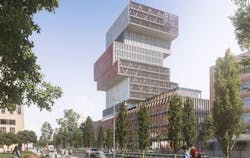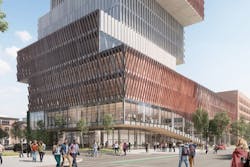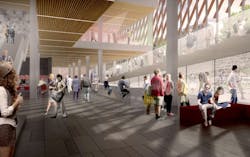17-story Data Sciences building to rise on Boston University campus
The design of Boston University’s Data Science building is sure to turn some heads when it completes in 2022. The 17-story, 345,000-sf building will resemble a stack of books rising up from a podium on the university’s central campus. For the first time, BU’s mathematics, statistics, and computer science departments will be under one roof, maximizing collaboration, interaction, and interconnectivity.
The building’s transparent, porous podium will occupy the entire width of the site to complete the streetscape and generate maximum group floor animation on Commonwealth Avenue. It will rise four-stories and accommodate the larger programmatic volumes and offer a series of zones for interaction, including the Cafe, the Cascading Stair, the Street Studio, and the Fireplace Lounge.
Atop the podium will sit an additional 13 floors, each one slightly off center from the one below to create the stack of books aesthetic. Floors three through five will house the mathematics and statistics department (the fifth floor will also have a lunch space and meeting rooms). Floors six through 10 will comprise mainly space for the computer science department. The interdisciplinary Hariri Institute will be located on the top six floors, with floors 11 and 12 housing administrative offices.
See Also: Denning House completes at Stanford University
The building will include a series of terraced platforms for small group interaction, whiteboard walls, and a collaboration ramp stippled with gathering spaces.
On the team: BRA (MEP), Entuitive + LeMessurier (structural engineer), Richard Burck (landscape architect), and Nitsch Engineering (civil engineer). Construction is expected to begin this spring.



